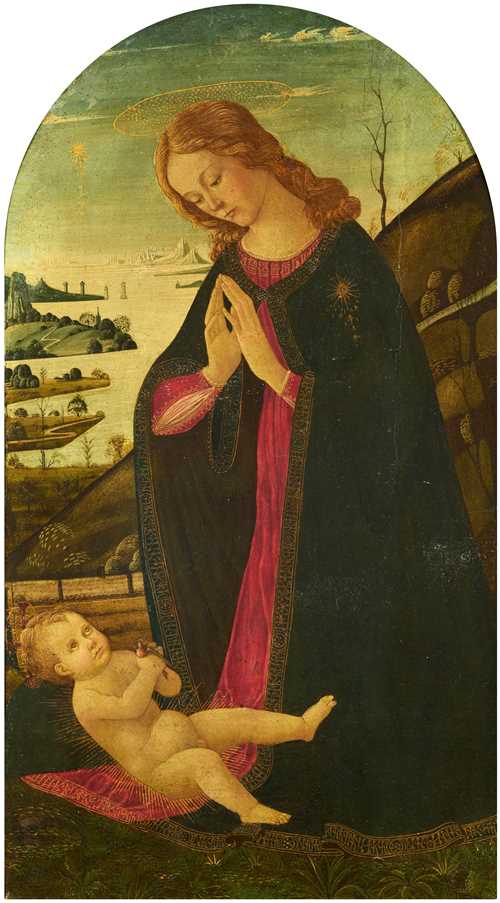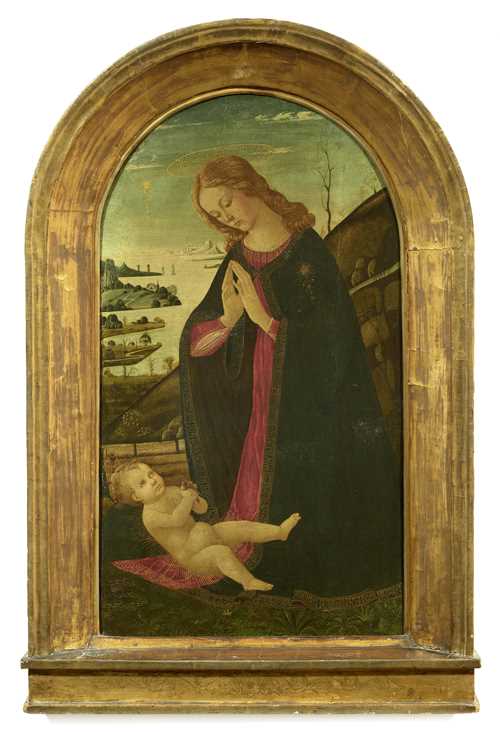
Lot 3003 - A204 Old Master Paintings - Friday, 31. March 2023, 02.00 PM
JACOPO DEL SELLAIO and Studio
Provenance:
- Collection of Baron Hans von Schoen (1876–1969).
- By descent to his son Leonardo von Schoen (1929–2022).
With an extensive art historical analysis by Prof. Gaudenz Freuler, Jan 2023.
The present Florentine Renaissance panel with its charming depiction of the Adoration of the Child represents an extract from the iconography of the Nativity specifically designed for its function as a devotional picture and illustrates the isolated moment of Mary’s adoration of the new-born Child from Heaven. The focus on the adoration of the new-born Holy Child, eschewing any kind of narrative and confining itself in this form to the intimate meditation of the Holy Mother, was intended to serve as a model for the viewer for their own silent contemplation before the painting. In the course of the 15th century, this mode of representation became established as an archetypal picture for private devotion, which was frequently produced in Florence. This meditative and self-contained Nativity picture was largely developed in Fra Filippo Lippi's (c. 1406–1469) workshop, as can be easily seen in his Adoration of the Child in the Staatliche Gemäldesammlung in Berlin (c. 1455–60, inv. no. 69).
This type of Florentine picture for private devotion with the Adoration of the Child was not only produced in later decades in commercially oriented and artisan painters' workshops but was also further developed in the workshops of the leading Florentine painters. This also applies to Jacopo del Sellaio, from whose workshop the present panel emerged. It is above all Jacopo's painting in the Metropolitan Museum in New York (inv. no. 41.100.10) to which our panel shows a close connection. This applies not only to the similarly drawn and subtly fashioned girlish face of the Virgin, where the fine modelling is reminiscent of paintings by the young Filippino Lippi, but also the way Flemish landscapes were received which resulted in an increasing meticulousness in Florentine Renaissance painting. These river landscapes with sweeping views of distant mountains, as in the present painting of the Virgin Mary, were repeatedly used as backgrounds in various ways and became a standard in Sellaio's oeuvre.
The artistic connection between our panel and Sellaio's similar adoration panels does not necessarily mean that it is a work by Sallaio himself, for the execution of these devotional pictures was often left to the workshop, which at the time in question also belonged to Jacopo Sellaio's son, Arcangelo di Jacopo del Sellaio (c. 1477/78–1530). Our panel is stylistically linked to an Adoration of the Child formerly owned by the Galleria Moretti in Florence, which seems to have resulted from a collaboration between Jacopo del Sellaio and his son Arcangelo. This would place our Madonna in Sellaio's late period, circa 1490–93.
The provenance of this panel is also noteworthy. It comes from the collection of the German diplomat Baron von Schoen (1876–1969), son of an industrialist from Worms. Hans von Schoen studied law in Munich and Berlin and joined the Bavarian judicial and administrative service in 1898. After assignments at the embassies of Vienna, St. Petersburg and Rome, he worked from 1910 to 1918 as a privy counsellor and chargé d'affaires at the Bavarian embassy in Berlin. In 1920 he was a counsellor in the service of the Foreign Office of the German Reich in Vienna, later as envoy to Poland, from 1922 to 1926 as envoy to Greece and, until 1933, envoy to Hungary, where his son Leonardo von Schoen was born (Fig. 1). After the National Socialists came to power, von Schoen, who was an avowed opponent of the regime, retired in 1933. His Munich villa served as a domicile for the Swiss representative office, and he himself died in 1969 at his country estate in Cureglia near Lugano in Switzerland. Von Schoen, who had already inherited an extensive art collection from his father, assembled an outstanding collection of ancient Greek art at an early age, which he bequeathed to the Staatliche Antikensammlungen in Munich in 1964. Von Schoen had been an honorary member of the Archaeological Institute of the German Reich since 1926.
CHF 40 000 / 60 000 | (€ 41 240 / 61 860)
Sold for CHF 165 000 (including buyer’s premium)
All information is subject to change.


